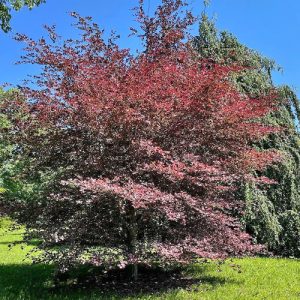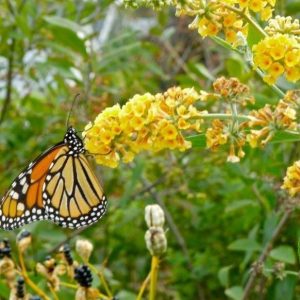With its dense green, feathery year-round foliage and pyramidal, upright habit, the Steeplechase Arborvitae makes an attractive addition to the landscape wherever it is used. Due to its smaller size, it even works well in landscapes that are not large. Compared to many Arborvitae, it has a faster rate of growth, adding around 2 feet to it’s height each year. At maturity the conifer reaches anywhere from 20 to 30 feet tall and with a mature width of 6 to 8 feet.
- Rich, green color year-round
- Brings color to fall and winter gardens
- Relatively drought-tolerant once established
- Useful as hedge, screen or windbreak
- Low maintenance requirements
Steeplechase Arborvitae thrives in sites located in full sun to partial sun and grows into a tall, densely foliaged shrub. However, if you plant in a location that is too shady throughout the day, the conifer loses some of its density. Although it might live in the shadier conditions, it will not take on its robust and thick natural beauty when grown in sunnier sites.
This evergreen conifer has an upright, pyramidal shape with its dense and deeply green canopy made up of finely textured foliage. Keeping its rich color year-round, Steeplechase Arborvitae adds warmth and greenery to garden areas in winter that may naturally lose their color during the colder months of the year.
Steeplechase Arborvitae takes whatever winter throws at it in USDA planting zone 4 without skipping a beat. Gardeners in this area who would love to grow a cypress but their winter conditions are too cold, cannot go wrong with this conifer look alike. It performs well all the way down to warmer USDA planting zone 8, where winter lows are not as intense. However, the Arborvitae won’t thrive in locations that are consistently warmer than zone 8 throughout the year.
Growing Steeplechase Arborvitae
Compared to many other types of Arborvitae, Steeplechase grows relatively quickly, achieving around 2 feet of new growth each year. This means you don’t have to wait a lifetime for it to achieve its mature size. To keep the shrub looking tidy and neat, you can do some shaping in spring. To prevent the transfer of disease and pests to the conifer, always use sterilized pruning tool blades before you start trimming.
This is a suitable choice for those who do not relish spending all their time in the garden tending to fussy and high-maintenance plants. Steeplechase is considered low-maintenance, especially when grown in preferred conditions and the root system establishes itself into the new planting site. However, during summers that are hot and dry, you may have to give it an additional application of water. Once spring arrives, feed the conifer with an all-purpose blend specific to trees and it should thrive in the landscape for many years to come.
Uses on Your Property
Besides its lush, green beauty Steeplechase brings to garden, it is a workhorse that fulfills a variety of needs in the landscape. Its broad growth habit and the density of its foliage makes it a superb selection to use as a hedging or screening plant, as it gives you the privacy desired. Use it as a barrier to block noise from traffic or an unsightly neighbor or building. Its durability also makes it work well used as a windbreak.
It also adds eye-catching appeal used to line a driveway or walkway into the house. In addition, use it along borders, planted in mass, to accent plants with different forms and colors in mixed gardens and its stunning beauty makes it a striking specimen. Steeplechase also works well used to add definition to a pond.
If you have areas that lose their colorful appeal during fall and winter because all the shrubs and trees are deciduous and drop their leaves, Steeplechase is a wonderful addition to these areas with its year-round green color. Its durability and hardiness makes it a welcome and beautiful addition wherever you decide to use it.
Planting and Initial Care
When selecting the best location to plant your Steeplechase Arborvitae where it will achieve its robust growth and density, plant it in a site that receives full sun to partial sun throughout the day. If you plant the shrub in a location that is too shady it will lose some of its thick density and won’t thrive as well as it would in a sunnier location.
Steeplechase Arborvitae tolerates a wide range of soil types provided they drain well. However, for the best growth and performance, plant the conifer in fertile, well-drained soil. If your soil lacks nutrients, you can amend the planting site with compost or well-rotted manure. Just spread it over the area and work into the soil before you plant.
If you are planting multiple Steeplechase Arborvitae to use as a hedge, screen or windbreak, consider the shrubs mature width and space accordingly. You do not want to bunch them too tightly together, but allow an adequate amount of air to circulate between them. This cuts down on potential problems with disease.
During the first season of growth and while the root system is establishing itself, water several times each week, especially if conditions are hot and dry. After that, Steeplechase Arborvitae is relatively tolerant to drought. In springtime, feed with an all-purpose blend specific to trees.










